QuickLinks:
4350, 4351, 4352, 4353, 4354, 4355, 4356, 4357, 4358, 4359, 4360, 4361, 4362, 4363, 4364, 4365, 4366,
4367, 4368, 4369, 4370, 4371, 4372, 4373, 4374, 4375, 4376, 4377, 4378, 4379, 4380, 4381, 4382, 4383,
4384, 4385, 4386, 4387, 4388, 4389, 4390, 4391, 4392, 4393, 4394, 4395, 4396, 4397, 4398, 4399
Page last updated Sep 26, 2023 (Added an image, partially updated NGC 4372, and fixed a broken link)
Page last updated Sep 25, 2023 (Added Caldwell & other IDs as part of update of NGC 4372)
Page last updated Jul 10, 2020
Completed entry for NGC 4385, which is a barred spiral, not a lenticular galaxy
WORKING: Updating to standard formatting: REMOVE TITLE TAGS
Updated and completed NGC 4380 w/HST image, historical/physical info
Checked Corwin positions
WORKING: Add historical, physical information
NGC 4350 (= PGC 40295)
Discovered (Mar 21, 1784) by William Herschel
An 11th-magnitude lenticular galaxy (type SA0) in Coma Berenices (RA 12 23 57.8, Dec +16 41 36)
Based on a recessional velocity of 1200 km/sec, NGC 4350 is about 55 million light years away, in good agreement with redshift-independent distance estimates of 50 to 55 million light years. Given that and its apparent size of 3.0 by 1.4 arcmin, it is about 50 thousand light years across. The galaxy is generally thought to be paired with NGC 4340. It is listed as a member (VCC 692) of the Virgo Cluster. 
Above, a 3 arcmin wide closeup of NGC 4350
Below, a 12 arcmin wide region centered between it and NGC 4340

NGC 4351 (= NGC 4354 = PGC 40306)
Discovered (May 19, 1863) by Heinrich d'Arrest (and later listed as NGC 4351)
Discovered (Apr 17, 1887) by Lewis Swift (and later listed as NGC 4354)
A 13th-magnitude spiral galaxy (type SB(rs)ab pec?) in Virgo (RA 12 24 01.5, Dec +12 12 17)
Per Dreyer, NGC 4351 (GC 5641, d'Arrest, 1860 RA 12 16 54, NPD 77 01.1) is "faint, pretty large, irregularly round, brighter middle". The position precesses to RA 12 24 00.5, Dec +12 12 19, right on the galaxy, so the identification is certain (see NGC 4354 for a discussion of the double listing).
Apparent size 2.0 by 1.4 arcmin. Listed as a member (VCC 692) of the Virgo Cluster.

Above, a 2.4 arcmin wide closeup of NGC 4351
Below, a 12 arcmin wide region centered on the galaxy

NGC 4352 (= PGC 40313)
Discovered (Mar 15, 1784) by William Herschel
A 13th-magnitude lenticular galaxy (type S0) in Virgo (RA 12 24 05.0, Dec +11 13 05)
Apparent size 2.0 by 1.0 arcmin. Listed as a member (VCC 698) of the Virgo Cluster.

Above, a 2.4 arcmin wide closeup of NGC 4352
Below, a 12 arcmin wide region centered on the galaxy

NGC 4353 (= IC 3266 = PGC 40303)
Discovered (1881) by Christian Peters (and later listed as NGC 4353)
Discovered (Nov 20, 1899) by Arnold Schwassmann (and later listed as IC 3266)
A 14th-magnitude irregular galaxy (type IBm?) in Virgo (RA 12 24 00.2, Dec +07 47 07)
Apparent size 0.9 by 0.6 arcmin. Listed as a member (VCC 688) of the Virgo Cluster. (See IC 3266 for a discussion of the duplicate listing.)

Above, a 2.4 arcmin wide closeup of NGC 4353
Below, a 12 arcmin wide region centered on the galaxy

NGC 4354 (= NGC 4351 = PGC 40306)
Discovered (May 19, 1863) by Heinrich d'Arrest (and later listed as NGC 4351)
Discovered (Apr 17, 1887) by Lewis Swift (and later listed as NGC 4354)
A 13th-magnitude spiral galaxy (type SB(rs)ab pec?) in Virgo (RA 12 24 01.5, Dec +12 12 17)
Per Dreyer, NGC 4354 (Swift list VI (#42), 1860 RA 12 16 59, NPD 77 01.5) is "most extremely faint, pretty large, very difficult". The second IC adds "Not found by Frost on plate of 4 hours exposure". The position precesses to RA 12 24 05.5, Dec +12 11 55, just east of NGC 4351 (which see for anything else), and there is nothing else nearby. Per Corwin, Swift's note read "in vacancy", meaning that there was nothing else near his #42, so there is no doubt that this is a reobservation of NGC 4351. Given that, it is hardly surprising that Frost was unable to find a second object in the field, nor that the identity with NGC 4351 was suggested early on.
NGC 4355 (= NGC 4418 = PGC 40762)
Discovered (Jan 1, 1786) by William Herschel (and later listed as NGC 4418)
Discovered (Feb 5, 1878) by David Todd (and later listed as NGC 4355)
A 13th-magnitude spiral galaxy (type (R')SAB(s)a) in Virgo (RA 12 26 54.6, Dec -00 52 40)
Per Dreyer, NGC 4355 (Todd (#17), 1860 RA 12 17, NPD 90 14) is "extremely faint, small, round". The position precesses to RA 12 24 10.4, Dec -01 00 35, but there is nothing there or anywhere near there. Todd's nebular discoveries were the accidental result of his search for a trans-Neptunian planet, and their positions were very crudely measured (in this case, with an error of more than half a degree west of the correct position), so the duplicate entry was inevitable. However, per Corwin, Todd made accurate sketches of the field of view, and as a result it is certain that what he observed in 1878 was the same galaxy discovered by Herschel nearly a century earlier. Given Todd's poor position and Herschel's prior discovery, the later "discovery" should be ignored, and NGC 4418 used as the name for this object; but that is the opposite of current usage, so rather than risk confusing the matter I have followed that usage, and made this the main entry for the object. Apparent size 1.5 by 0.7 arcmin. A Seyfert galaxy (type Sy 2).

Above, a 2.4 arcmin wide closeup of NGC 4355
Below, a 12 arcmin wide region centered on the galaxy
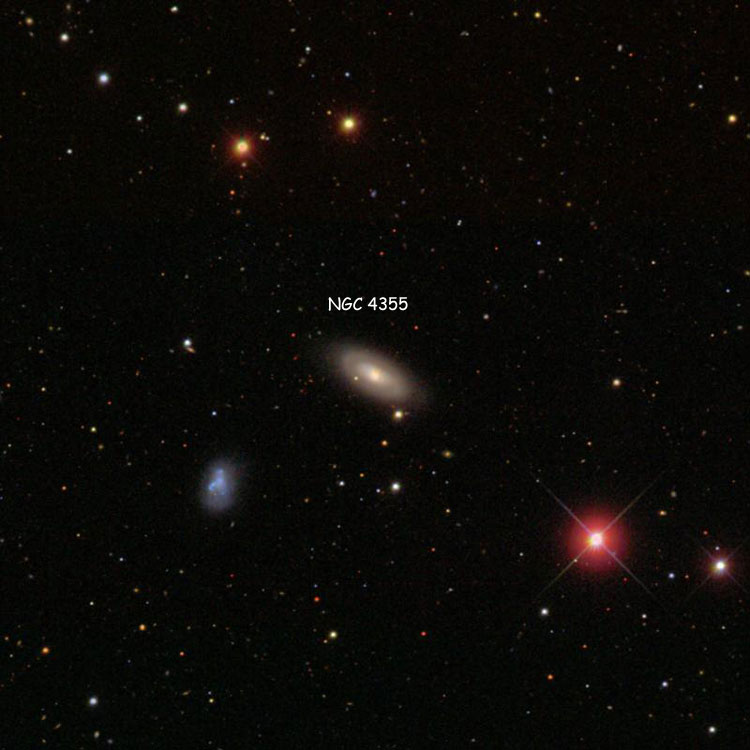
NGC 4356 (= IC 3273 = PGC 40342)
Discovered (Dec 28, 1785) by William Herschel (and later listed as NGC 4356)
Discovered (Jan 23, 1900) by Arnold Schwassmann (and later listed as IC 3273)
A 13th-magnitude spiral galaxy (type Scd?) in Virgo (RA 12 24 14.8, Dec +08 32 14)
Apparent size 2.8 by 0.5 arcmin. Listed as a member (VCC 713) of the Virgo Cluster. (See IC 3273 for a discussion of the duplicate entry.)

Above, a 2.4 arcmin wide closeup of NGC 4356
Below, a 12 arcmin wide region centered on the galaxy

NGC 4357 (= NGC 4381 = PGC 40296)
Discovered (Feb 9, 1788) by William Herschel (and later listed as NGC 4381)
Discovered (Mar 8, 1886) by Guillaume Bigourdan (and later listed as NGC 4357)
A 12th-magnitude spiral galaxy (type SAbc) in Canes Venatici (RA 12 23 58.9, Dec +48 46 46)
Per Dreyer, NGC 4357 (Bigourdan (list II #52), 1860 RA 12 17 07, NPD 40 26.4) is "faint, pretty small, gradually brighter middle (= II 743?)", (WH) II 743 being NGC 4381 (which see for a discussion of the duplicate listing). The position precesses to RA 12 23 57.9, Dec +48 47 01, right on the galaxy, so the identification is certain. Apparent size 3.7 by 1.3 arcmin.

Above, a 4 arcmin wide closeup of NGC 4357
Below, a 12 arcmin wide region centered on the galaxy

NGC 4358 (= PGC 40309)
Discovered (Apr 17, 1789) by William Herschel
A 13th-magnitude lenticular galaxy (type S0) in Ursa Major (RA 12 24 02.0, Dec +58 23 07)
Per Dreyer, NGC 4358 (GC 2914 = JH 1230 = WH III 799, 1860 RA 12 17 09, NPD 30 50.5) is "extremely faint, extremely small, a little elongated". The position precesses to RA 12 24 01.5, Dec +58 22 55, right on the galaxy listed above, so the identification is certain. However, that galaxy is often mistakenly called NGC 4362 or 4364, which see for the confused history of the three entries. One result of that confusion is that PGC 40314, the faint galaxy southwest of NGC 4358, is often misidentified as NGC 4358; for that reason, it is discussed immediately following. Apparent size 1.15 by 1.1 arcmin.

Above, a 2.4 arcmin wide closeup of NGC 4358, also showingPGC 40314
Below, a 12 arcmin wide region centered on the pair; also shown is NGC 4362

PGC 40314 (not = NGC 4358)
Not an NGC object but listed here since often misidentified as NGC 4358
A 16th-magnitude lenticular galaxy (type S0?) in Ursa Major (RA 12 23 57.5, Dec +58 22 50)
References that mistakenly identify NGC 4358 as some other NGC object usually (also mistakenly) assign PGC 40314 to NGC 4358 (which see for images). Apparent size 0.3 by 0.2 arcmin.
NGC 4359 (= PGC 40330)
Discovered (Mar 20, 1787) by William Herschel
A 13th-magnitude spiral galaxy (type SB(rs)c?) in Coma Berenices (RA 12 24 11.5, Dec +31 31 16)
Apparent size 3.5 by 0.8 arcmin.

Above, a 4 arcmin wide closeup of NGC 4359
Below, a 12 arcmin wide region centered on the galaxy
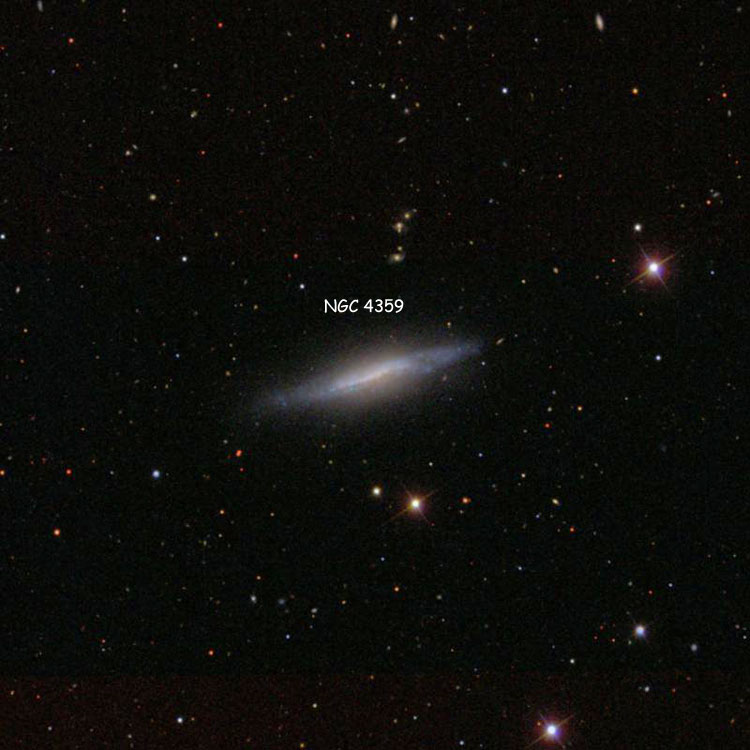
NGC 4360 (= PGC 40363)
Discovered (1877) by Wilhelm Tempel (I-43)
A 12th-magnitude elliptical galaxy (type E2) in Virgo (RA 12 24 21.7, Dec +09 17 34)
Apparent size 1.5 by 1.2 arcmin. Listed as a member (VCC 722) of the Virgo Cluster.
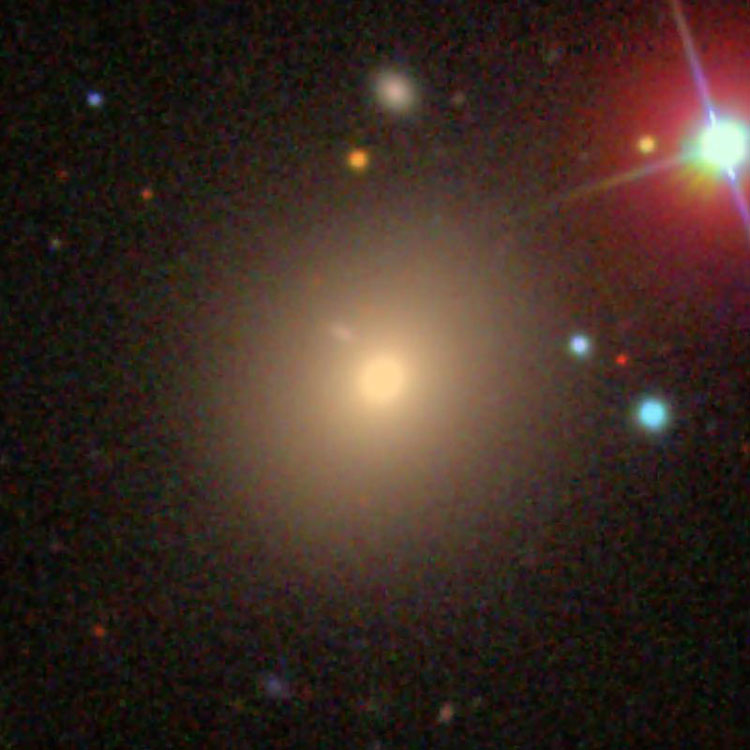
Above, a 2.4 arcmin wide closeup of NGC 4360
Below, a 12 arcmin wide region centered on the galaxy, also showing IC 3274
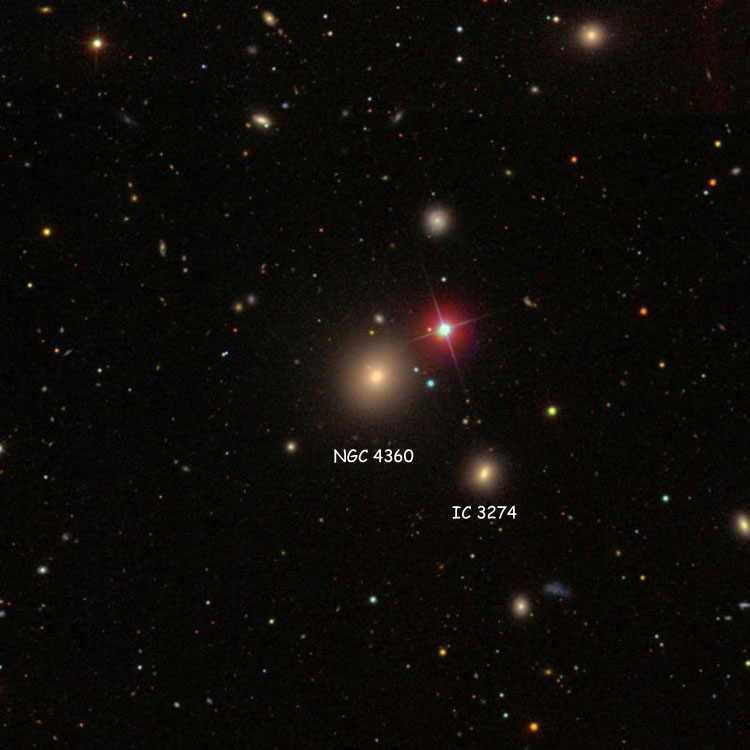
IC 3274 (= PGC 40344 = "NGC 4360B")
Not an NGC object but sometimes improperly called NGC 4360B due to its proximity to NGC 4360
A 14th-magnitude lenticular galaxy (type S0) in Virgo (RA 12 24 14.7, Dec +09 16 01)
NGC 4361 (= P-K 294+43.1 = "PGC 3517769")
Discovered (Feb 7, 1785) by William Herschel
An 11th-magnitude planetary nebula in Corvus (RA 12 24 30.8, Dec -18 47 06)
Historical Identification:
PGC Designation Note: For purposes of completeness, LEDA assigns a PGC designation to this object, even though it isn't a galaxy; but a search of the database for that designation returns no result, so it is shown in quotes.
Physical Information: Apparent size 2.1 arcmin.
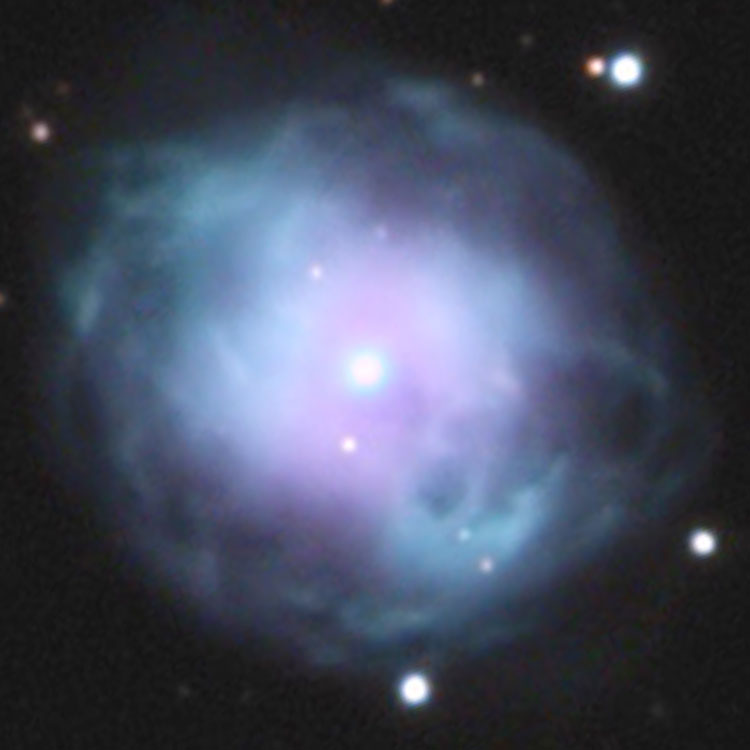
Above, a 2.4 arcmin wide closeup of NGC 4361
(Image Credit above and below: Adam Block/Mount Lemmon SkyCenter/University of Arizona/Creative Commons)
Below, a 12 arcmin wide region centered on the nebula
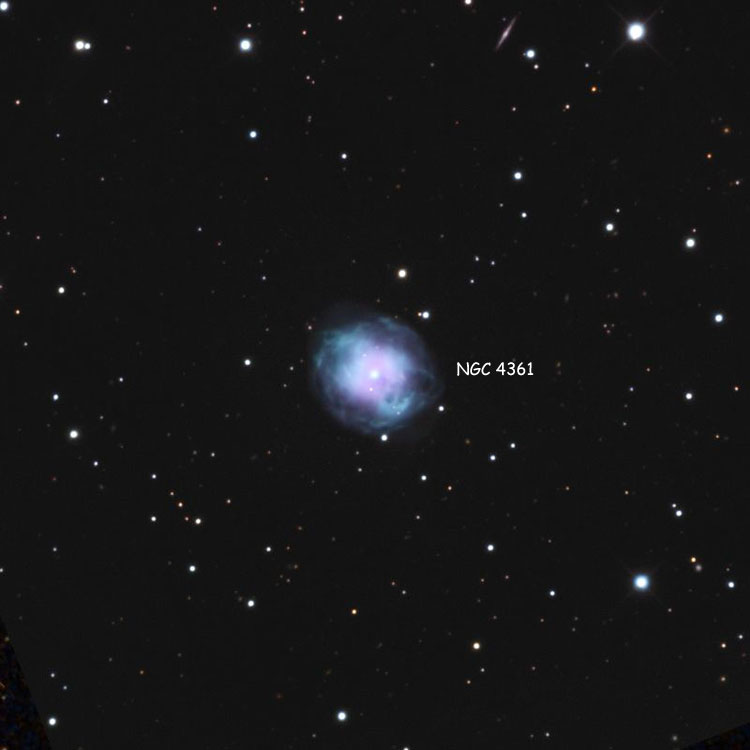
NGC 4362 (= NGC 4364 = PGC 40350)
Discovered (Apr 17, 1789) by William Herschel (and later listed as NGC 4362)
Discovered (Apr 17, 1789) by William Herschel (and later listed as NGC 4364)
A 14th-magnitude lenticular galaxy (type S0/a) in Ursa Major (RA 12 24 11.4, Dec +58 21 38)
The confused history of NGC 4358, 4362 and 4364 will be discussed here in the next iteration of this page. The upshot is that NGC 4362 is the galaxy listed above, and NGC 4364 is a duplicate entry for that galaxy; an unfortunate side effect is that NGC 4358 is often mistakenly identified as NGC 4362 or 4364, and PGC 40314, the faint galaxy southwest of NGC 4358, is often misidentified as NGC 4358. Apparent size 1.1 by 0.4 arcmin.

Above, a 2.4 arcmin wide closeup of NGC 4362
Below, a 12 arcmin wide region centered on the galaxy; also shown are NGC 4358 and PGC 40314

NGC 4363 (= PGC 40233)
Discovered (Dec 10, 1797) by William Herschel
A 14th-magnitude spiral galaxy (type SAb?) in Draco (RA 12 23 28.8, Dec +74 57 09)
Based on a recessional velocity of 1425 km/sec, NGC 4363 is about 65 million light years away. Given that and its apparent size of 0.65 by 0.55 arcmin, it is about 13 thousand light years across.

Above, a 2.4 arcmin wide closeup of NGC 4363
Below, a 12 arcmin wide region centered on the galaxy

NGC 4364 (= NGC 4362 = PGC 40350)
Discovered (Apr 17, 1789) by William Herschel (and later listed as NGC 4362)
Discovered (Apr 17, 1789) by William Herschel (and later listed as NGC 4364)
A 14th-magnitude lenticular galaxy (type S0/a) in Ursa Major (RA 12 24 11.4, Dec +58 21 38)
The confused history of NGC 4358, 4362 and 4364 will be discussed here in the next iteration of this page. The upshot is that NGC 4362 (which see for images and anything else) is the galaxy listed above, and NGC 4364 is a duplicate entry for that galaxy; an unfortunate side effect is that NGC 4358 is often mistakenly identified as NGC 4362 or 4364, and PGC 40314, the faint galaxy southwest of NGC 4358, is often misidentified as NGC 4358.
NGC 4365 (= PGC 40375)
Discovered (Apr 13, 1784) by William Herschel
A 10th-magnitude elliptical galaxy (type E3) in Virgo (RA 12 24 28.3, Dec +07 19 04)
Apparent size 6.9 by 5.0 arcmin. Listed as a member (VCC 731) of the Virgo Cluster.
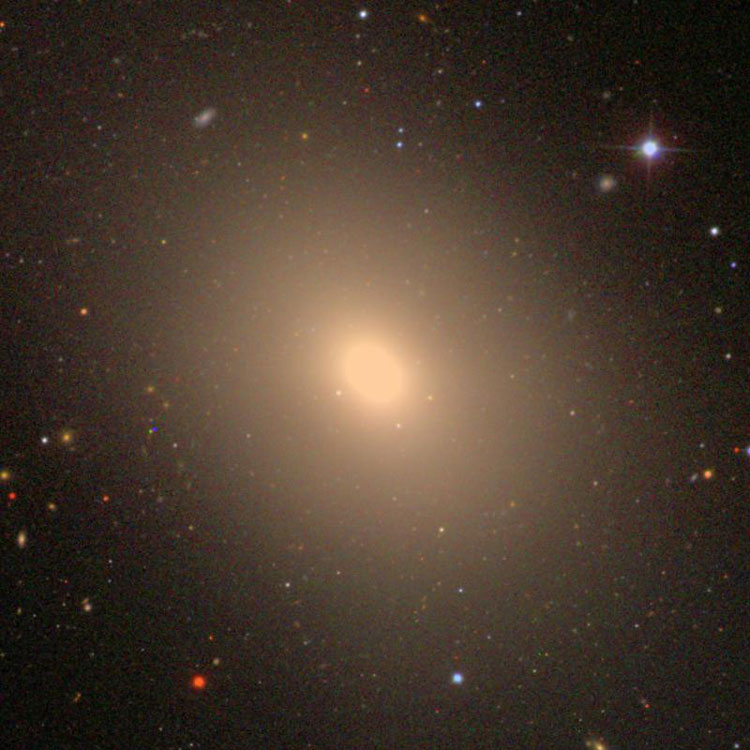
Above, a 7 arcmin wide closeup of NGC 4365
Below, a 12 arcmin wide region centered on the galaxy, also showing NGC 4366

NGC 4366 (= PGC 40421)
Discovered (Apr 13, 1784) by William Herschel
A 14th-magnitude elliptical galaxy (type E5?) in Virgo (RA 12 24 47.0, Dec +07 21 11)
Apparent size 0.8 by 0.4 arcmin. Listed as a member (VCC 745) of the Virgo Cluster.

Above, a 7 arcmin wide closeup of NGC 4366
Below, a 12 arcmin wide region centered on the galaxy, also showing NGC 4365 and 4370

NGC 4367
Recorded (Apr 19, 1865) by Heinrich d'Arrest
A magnitude 14.8 and 17.2 pair of stars in Virgo (RA 12 24 35.2, Dec +12 10 54)
Per Dreyer, NGC 4367 (GC 5643, d'Arrest, 1860 RA 12 17 32, NPD 77 02.7) is "very faint, small, round". The second IC adds "Not found by Frost on plate of 4 hours exposure". The position precesses to RA 12 24 38.4, Dec +12 10 43, but there is nothing there (as noted by Frost). However, per Corwin, it is reasonably certain that what d'Arrest observed was the pair of stars three seconds west of the NGC position, as d'Arrest noted that the object was 35 seconds east of another nebula found by him, and the pair of stars is 35 seconds east of NGC 4351, which was one of his discoveries.

Above, a 12 arcmin wide region centered on NGC 4367
Below, a 12 arcmin wide region showing its position relative to NGC 4351

NGC 4368 (probably = NGC 4325 = PGC 40183)
Discovered (Mar 15, 1784) by William Herschel (and later listed as NGC 4368)
Discovered (Apr 15, 1865) by Heinrich d'Arrest (and later listed as NGC 4325)
A 13th-magnitude elliptical galaxy (type E3) in Virgo (RA 12 23 06.7, Dec +10 37 17)
Per Dreyer, NGC 4368 (GC 2923 = WH III 38, 1860 RA 12 17 35, NPD 78 38.0) is "very faint, very small". The second IC adds "Not found by Frost on plate of 4 hours exposure". The position precesses to RA 12 24 41.9, Dec +10 35 25, but there is nothing there (as noted by Frost and Bigourdan). However, per Corwin, Dreyer later noted that seven objects observed by Herschel on the night in question have right ascensions a minute or so too large, in which case NGC 4368 could be reasonably associated with NGC 4325 (which see for anything else). Whether it really is NGC 4325 is uncertain, as not all the objects observed on that night have similar errors; still, NGC 4368 is either NGC 4325 or a lost object.
NGC 4369 (= PGC 40396)
Discovered (Mar 17, 1787) by William Herschel
A 12th-magnitude spiral galaxy (type (R)SA(rs)a) in Canes Venatici (RA 12 24 36.2, Dec +39 22 59)
Apparent size 2.1 by 2.0 arcmin. A starburst galaxy.

Above, a 2.4 arcmin wide closeup of NGC 4369
Below, a 12 arcmin wide region centered on the galaxy
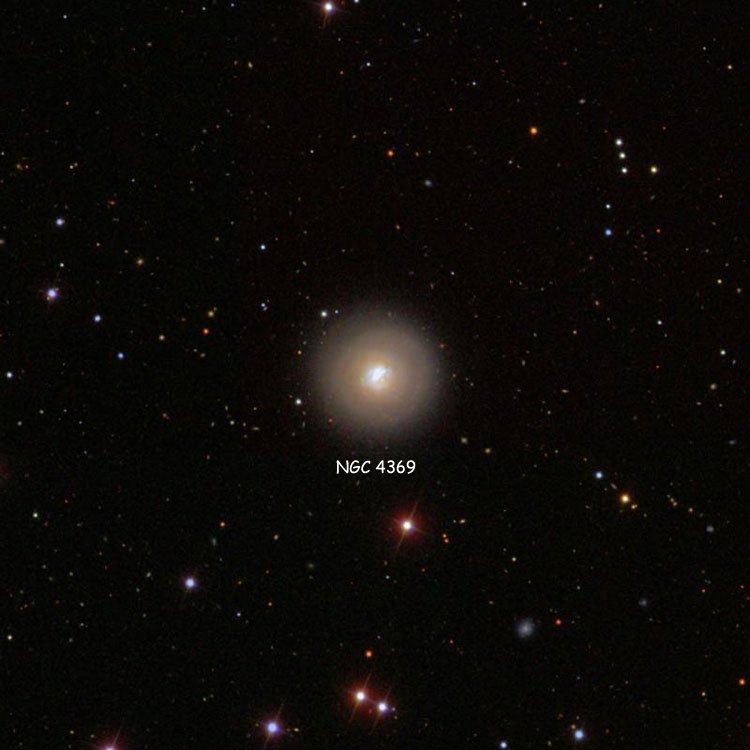
NGC 4370 (= PGC 40439)
Discovered (Apr 13, 1784) by William Herschel
A 13th-magnitude spiral galaxy (type Sa) in Virgo (RA 12 24 55.0, Dec +07 26 40)
Apparent size 1.3 by 0.7 arcmin. Listed as a member (VCC 758) of the Virgo Cluster.
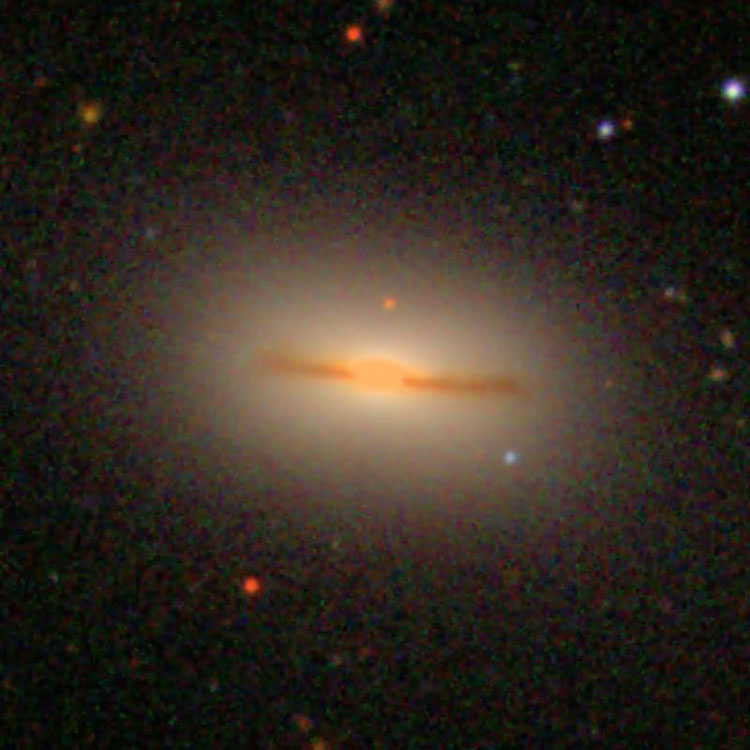
Above, a 2.4 arcmin wide closeup of NGC 4370
Below, a 12 arcmin wide region centered on the galaxy, also showing NGC 4366 and part of NGC 4365
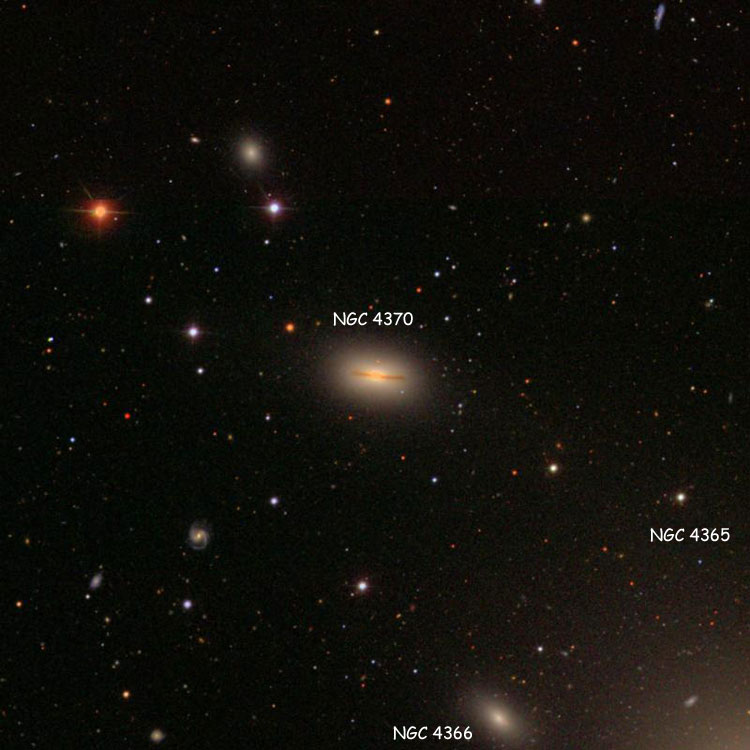
NGC 4371 (= PGC 40442)
Discovered (Mar 15, 1784) by William Herschel
An 11th-magnitude lenticular galaxy (type SB0/a) in Virgo (RA 12 24 55.4, Dec +11 42 15)
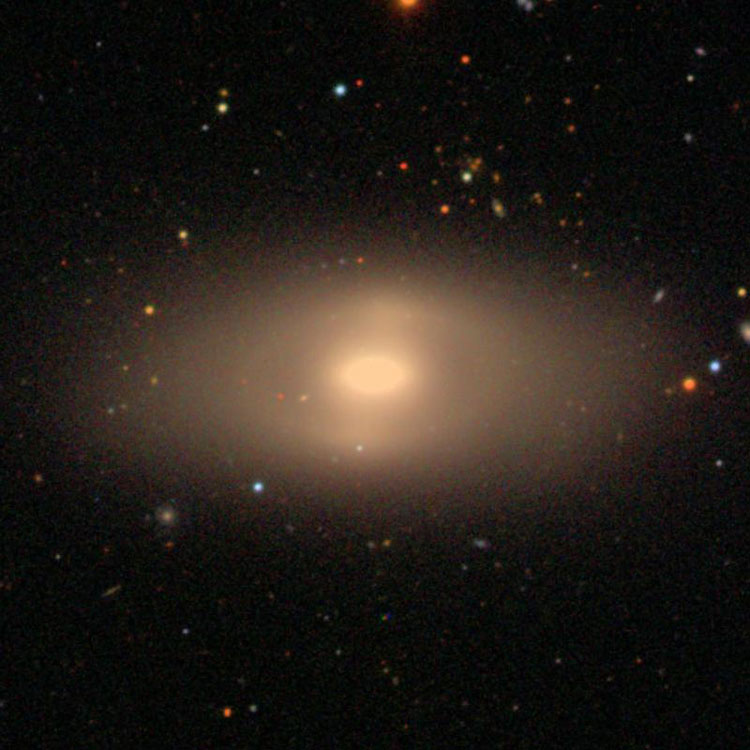
Above, a 6 arcmin wide closeup of NGC 4371
Below, a 12 arcmin wide region centered on the galaxy

NGC 4372
(= GCL 19 = C108 = ESO 064-SC006 = "PGC 3517716")
Discovered (Apr 30, 1826) by James Dunlop
Also observed (Apr 1, 1835) by John Herschel
A magnitude 7.2 globular cluster (type XII) in Musca (RA 12 25 46.7, Dcc -72 39 22)
Historical Identification: Per Dreyer, NGC 4372 (= GC 2927 = JH 3390, Dunlop #67??, 1860 RA 12 17 50, NPD 161 53.3) is "a globular cluster, pretty faint, large, round, stars from 12th to 16th magnitude." The position precesses to RA 12 25 56.0, Dec -72 39 52, slightly to the southeast of the center of the cluster listed above but well within its outline, the description fits and there is nothing comparable nearby, so the identification is certain.
PGC Designation Note: As usual for NGC objects, HyperLEDA assigned a PGC designation to this object, even though it isn't a galaxy; but as also usual in such cases a search of the database for that designation returns no result, hence its being in quotes.
Physical Information: Apparent size 18.6 arcmin. (Far more to be added as the Caldwell Catalogue entries are completed.)
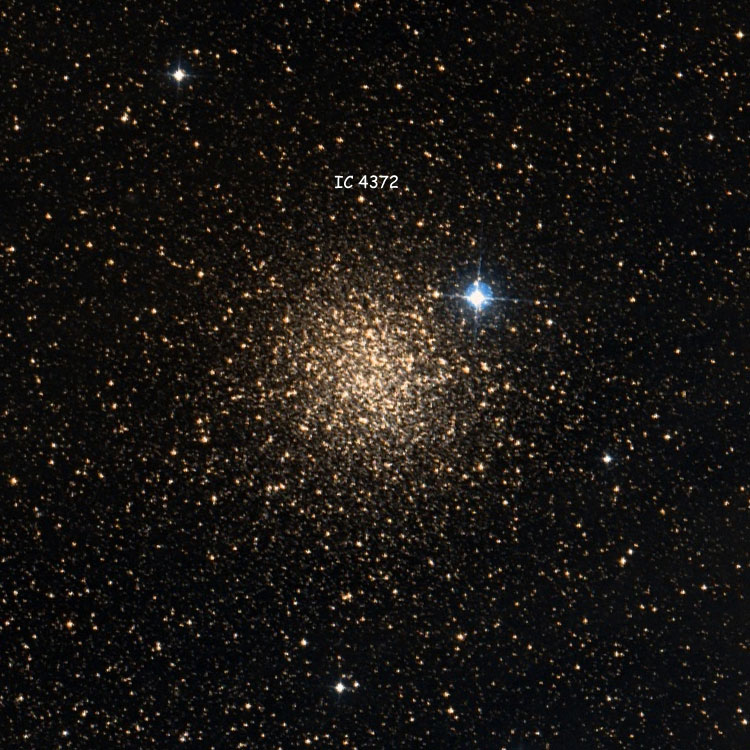
Above, a 30 arcmin wide DSS image centered on NGC 4372
Below, a 20 arcmin wide Observatorio Antilhue image of the cluster
(Image Credit and © Daniel Verschatse, Observatorio Antilhue, Chile; used by permission)

NGC 4373 (= PGC 40498)
Discovered (Jun 8, 1834) by John Herschel
An 11th-magnitude lenticular galaxy (type E/SB0) in Centaurus (RA 12 25 17.8, Dec -39 45 35)
Apparent size 3.6 by 2.6 arcmin.
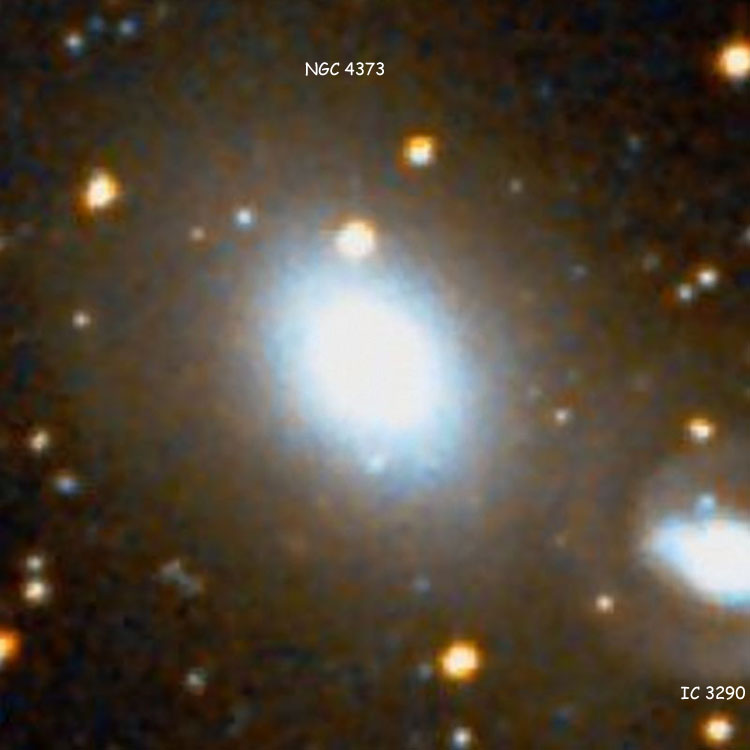
Above, a 3.6 arcmin wide closeup of NGC 4373, also showing part of IC 3290
Below, a sharper image (Image Credit & © Carnegie-Irvine Galaxy Survey; used by permission)

Below, a 12 arcmin wide region centered on the pair

PGC 40549 (= "NGC 4373A")
Not an NGC object but sometimes called NGC 4373A since in general vicinity of NGC 4373
A 12th-magnitude lenticular galaxy (type S0) in Centaurus (RA 12 25 37.7, Dec -39 19 11)
Apparent size 2.6 by 0.9 arcmin.
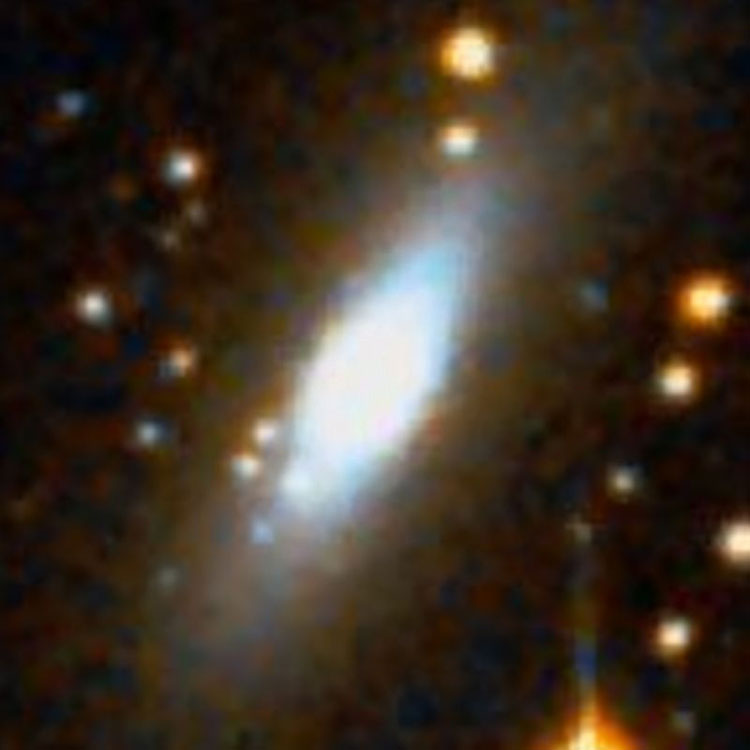
Above, a 2.4 arcmin wide closeup of PGC 40549
Below, a 12 arcmin wide region centered on the galaxy

PGC 40735 (= "NGC 4373B")
Not an NGC object but sometimes called NGC 4373B since in general vicinity of NGC 4373
A 14th-magnitude spiral galaxy (type SB(s)dm) in Centaurus (RA 12 26 43.8, Dec -39 08 03)
Apparent size 1.5 by 0.9 arcmin.
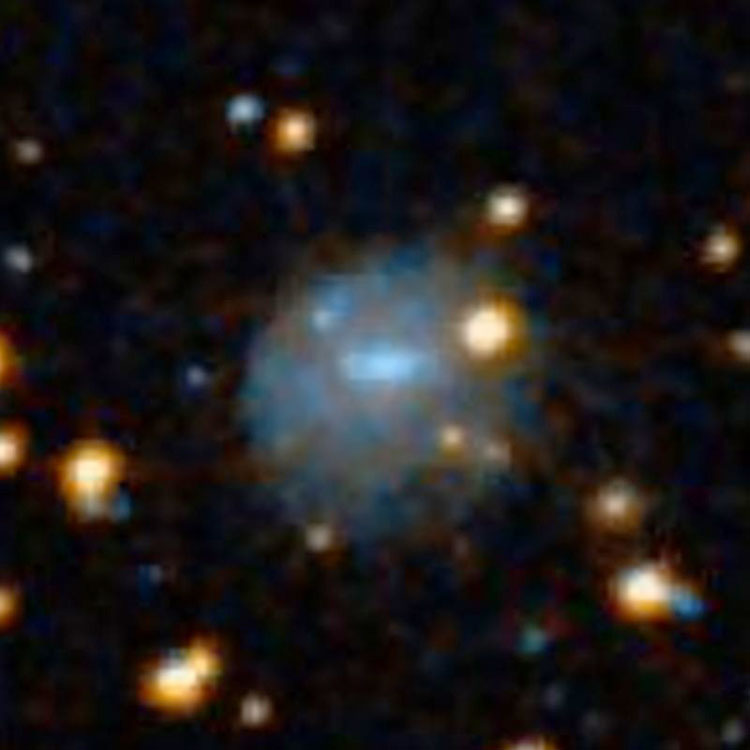
Above, a 2.4 arcmin wide closeup of PGC 40735
Below, a 12 arcmin wide region centered on the galaxy

NGC 4374 (= M84 = PGC 40455), part of Markarian's Chain
Discovered (May 5, 1779) by Johann Koehler
Rediscovered (Mar 18, 1781) by Charles Messier and recorded as M84
Also observed (May 4, 1829) by John Herschel
A magnitude 9.1 elliptical galaxy (type E1?) in Virgo (RA 12 25 03.7, Dec +12 53 13)
Historical Identification: Per Dreyer, NGC 4374 (= GC 2930 = JH 1237, M84, 1860 RA 12 17 58, NPD 76 20.2) is "very bright, pretty large, round, pretty suddenly bright middle, mottled but not resolved". The position precesses to RA 12 25 04.1, Dec +12 53 14, practically dead center on the galaxy listed above and the description fits, so the identification is certain.
Physical Information: Listed as a member (VCC 763) of the Virgo Cluster. Also part of Markarian's Chain, a group of Virgo Cluster galaxies that lie along a smooth curve and have similar radial velocities. Apparent size 6.5 by 5.6 arcmin.

Above, a 10 arcmin wide SDSS image of M84
Below, a 24 arcmin wide SDSS image centered on the galaxy, also showing NGC 4387 and IC 3303

Markarian's Chain
A string of galaxies in Virgo (RA 12 27 30, Dec +13 10 00)
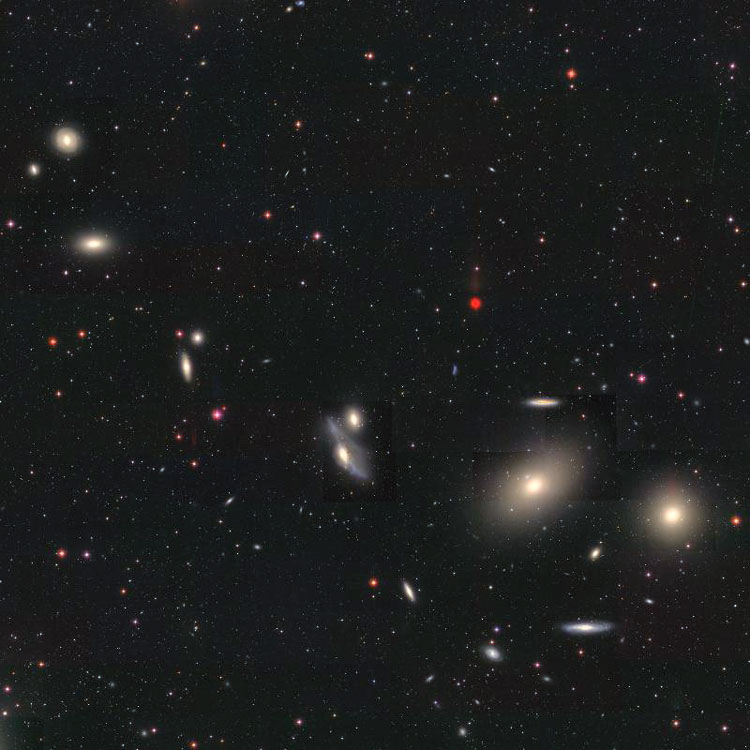
Above, a 1.5 degree wide view of Markarian's Chain
Below, the same image with labels for galaxies in the Chain
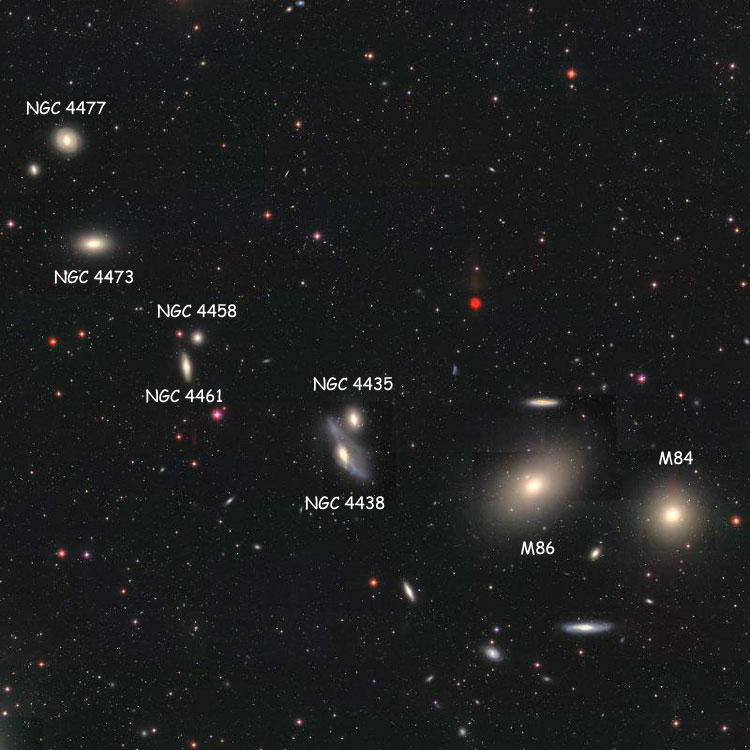
Below, the same image adding (smaller) labels for NGC/IC objects not in the Chain:
NGC 4387, 4388, 4402, 4413, 4425 and 4479, and IC 3303, 3344, 3349, 3363, 3388 and 3393

NGC 4375 (= PGC 40449)
Discovered (Apr 11, 1785) by William Herschel
A 13th-magnitude spiral galaxy (type SB(r)ab pec?) in Coma Berenices (RA 12 25 00.5, Dec +28 33 31)
Apparent size 1.4 by 1.2 arcmin.
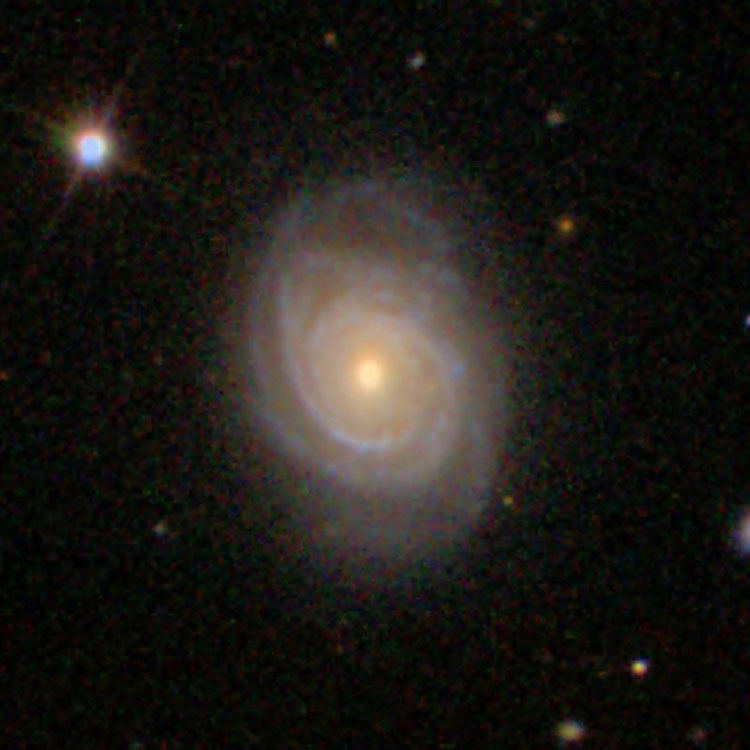
Above, a 2.4 arcmin wide closeup of NGC 4375
Below, a 12 arcmin wide region centered on the galaxy

Corwin lists an apparent companion (PGC 1840042) at RA 12 24 58.1, Dec +28 35 02
NGC 4376 (= PGC 40494)
Discovered (Feb 2, 1786) by William Herschel
A 13th-magnitude irregular galaxy (type Im) in Virgo (RA 12 25 18.1, Dec +05 44 28)
Apparent size 1.4 by 0.9 arcmin. Listed as a member (VCC 787) of the Virgo Cluster.

Above, a 2.4 arcmin wide closeup of NGC 4376
Below, a 12 arcmin wide region centered on the galaxy

NGC 4377 (= PGC 40477)
Discovered (Feb 19, 1784) by William Herschel
A 12th-magnitude lenticular galaxy (type E/S0) in Coma Berenices (RA 12 25 12.3, Dec +14 45 44)
Apparent size 1.7 by 1.3 arcmin. Listed as a member (VCC 778) of the Virgo Cluster. Apparently accompanied by two compact galaxies, PGC 40476 and 169245 (which is sometimes misidentified as PGC 40476) that are supposedly associated with it; but there appears to be no evidence that they are actually anywhere near it, save for being in the same direction (a third 'companion' is known to be at least twenty times further away, so merely being in the same direction does not guarantee any physical connection).

Above, a 2.4 arcmin wide closeup of NGC 4377, also showing PGC 169245 and 40476
Below, the same image with labels for the galaxies

Below, a 12 arcmin wide region centered on the galaxy

PGC 169245
Not an NGC object but listed here because of apparent association with NGC 4377
A 17th-magnitude compact galaxy (type S?) in Coma Berenices (RA 12 25 10.2, Dec +14 45 43)
Apparent size 0.2 by 0.1 arcmin. Apparently associated with NGC 4377 (which see for images), but there appears to be no evidence that they are actually connected in any way. Sometimes misidentified as PGC 40476, which is to the east of NGC 4377.
PGC 40476
Not an NGC object but listed here because of apparent association with NGC 4377
A 17th-magnitude compact galaxy (type C) in Coma Berenices (RA 12 25 13.4, Dec +14 45 52)
Apparent size 0.1 by 0.1 arcmin. Apparently associated with NGC 4377 (which see for images), but there appears to be no evidence that they are actually connected in any way.
NGC 4378 (= PGC 40490)
Discovered (Feb 2, 1786) by William Herschel
A 12th-magnitude spiral galaxy (type (R)SA(s)a) in Virgo (RA 12 25 18.1, Dec +04 55 30)
Apparent size 3.3 by 2.8 arcmin. Listed as a member (VCC 785) of the Virgo Cluster.

Above, a 3.6 arcmin wide closeup of NGC 4378
Below, a 12 arcmin wide region centered on the galaxy

NGC 4379 (= PGC 40484)
Discovered (Mar 21, 1784) by William Herschel
A 12th-magnitude lenticular galaxy (type E/S0) in Coma Berenices (RA 12 25 14.8, Dec +15 36 27)
Apparent size 2.0 by 1.6 arcmin. Listed as a member (VCC 784) of the Virgo Cluster.

Above, a 2.4 arcmin wide closeup of NGC 4379
Below, a 12 arcmin wide region centered on the galaxy

NGC 4380 (= PGC 40507)
Discovered (Mar 10, 1826) by John Herschel
Also observed (date?) by Arnold Schwassmann
Not observed (date?) by Royal Frost
A magnitude 11.7 spiral galaxy (type SA(rs)b?) in Virgo (RA 12 25 22.2, Dec +10 01 01)
Historical Identification: Per Dreyer, NGC 4380 (= GC 2944 = JH 1241, 1860 RA 12 18 17, NPD 79 13.0) is "very faint, pretty large, round, a little brighter middle". The second IC adds "Not found by Frost on plate of 4 hours exposure. 4380 is Schwassmann #138". The position precesses to RA 12 25 24.0, Dec +10 00 26, which lies to the southeast of the bright nucleus (possibly explaining Frost's failure to find the object), but well within the extended outline of the galaxy, so the identity is certain.
Discovery Note: Whether the date of Schwassmann's observation can be determined from his 1902 paper, or whether the date on which Frost exposed the photographic plate on which he could not find NGC 4380 can be determined from the Harvard paper remains to be seen. As a result, for now I am leaving the dates as simply a question; but when I update all the other dates on this page I will try to make the best possible estimate of the dates, and include a brief note here explaining how I came to those conclusions.
Physical Information: Based on a recessional velocity of 965 km/sec (and H0 = 70 km/sec/Mpc), NGC 4380 is about 45 million light years away, in reasonable agreement with widely varying redshift-independent distance estimates of 35 to 100 million light years. Given that and its apparent size of about 3.7 by 1.85 arcmin (from the images below), the galaxy is about 45 to 50 thousand light years across. It is listed as a member (VCC 792) of the Virgo Cluster (probably on the side of the cluster nearest us), and also as a Seyfert galaxy, because of its small but otherwise very bright center.

Above, a 12 arcmin wide SDSS image centered on NGC 4380
Below, a 3.6 arcmin wide SDSS image of the galaxy

Below, a 0.65 by 0.75 arcmin wide image of the core of the galaxy (Image Credit ESA/Hubble & NASA, P. Erwin)
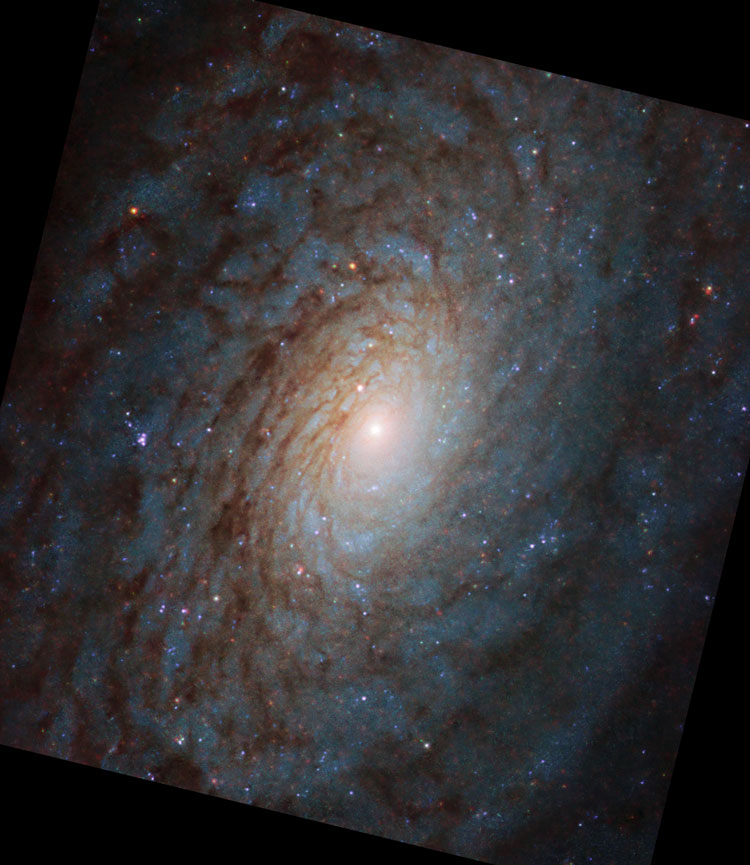
NGC 4381 (= NGC 4357 = PGC 40296)
Discovered (Feb 9, 1788) by William Herschel (and later listed as NGC 4381)
Discovered (Mar 8, 1886) by Guillaume Bigourdan (and later listed as NGC 4357)
A 12th-magnitude spiral galaxy (type SAbc) in Canes Venatici (RA 12 23 58.9, Dec +48 46 46)
Per Dreyer, NGC 4381 (GC 2945 = WH II 743, 1860 RA 12 18 19, NPD 40 24.0) is "faint, small". The position precesses to RA 12 25 08.7, Dec +48 49 26, but there is nothing there. However, NGC 4357 (which see for anything else) lies less than a quarter degree to the west southwest, and a one minute correction to Herschel's RA is all that would be required to put his position very close to that galaxy. Dreyer suggested the possibility that the two entries represented the same object in his description of NGC 4357, so the identity has been suspected right from the start, and is now considered certain.
NGC 4382 (= M85 = PGC 40515)
Discovered (Mar 4, 1781) by Pierre Méchain
Observed/recorded (March 18, 1781) by Charles Messier as M85
Also observed (Mar 23, 1827) by John Herschel
A magnitude 9.1 lenticular galaxy (type SA0(s)a? pec) in Coma Berenices (RA 12 25 24.1, Dec +18 11 28)
Historical Identification: Per Dreyer, NGC 4382 (= GC 2946 = JH 1242, Méchain, M85, 1860 RA 12 18 20, NPD 71 02.0) is "very bright, pretty large, round, brighter middle, star to northwest". The position precesses to RA 12 25 24.3, Dec +18 11 27, essentially dead center on the galaxy listed above and the description fits, so the identification is certain.
Physical Information: Apparent size 9.8 by 8.4 arcmin. Listed as a member (VCC 798) of the Virgo Cluster.

Above, a 12 arcmin wide SDSS image of NGC 4382
Below, a 24 arcmin wide SDSS image centered on the galaxy, also showing NGC 4394 & 4397 & IC 3292

NGC 4383 (= PGC 40516)
Discovered (May 23, 1862) by Eduard Schönfeld
A 12th-magnitude spiral galaxy (type Sa pec?) in Coma Berenices (RA 12 25 25.5, Dec +16 28 12)
Apparent size 2.0 by 1.0 arcmin. Listed as a member (VCC 801) of the Virgo Cluster. A starburst galaxy.

Above, a 2.4 arcmin wide closeup of NGC 4383
Below, a detail of the galaxy's starburst region (Image Credits: Hubble Legacy Archive, Wikimedia Commons)
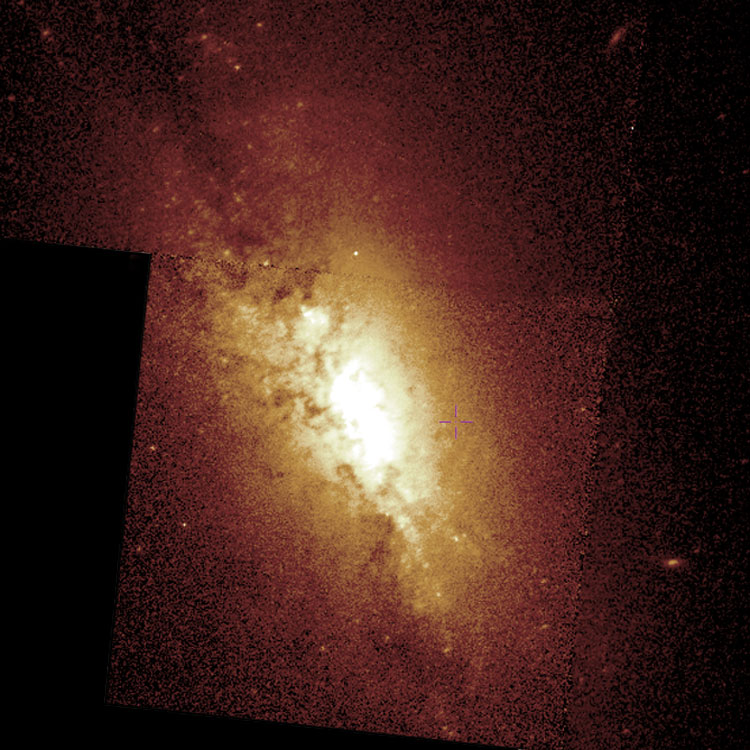
Below, a 12 arcmin wide region centered on the galaxy

Corwin lists an apparent companion (PGC 40506) at RA 12 25 21.6, Dec +16 25 47
NGC 4384 (= PGC 40475)
Discovered (Apr 2, 1791) by William Herschel
A 13th-magnitude spiral galaxy (type Sa pec?) in Ursa Major (RA 12 25 12.0, Dec +54 30 22)
Apparent size 1.3 by 1.0 arcmin. A starburst galaxy.
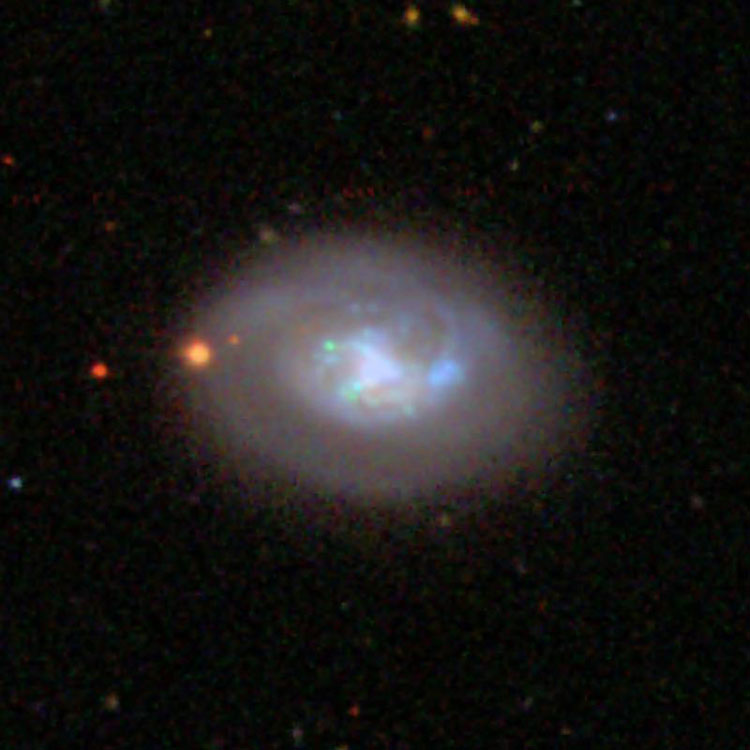
Above, a 2.4 arcmin wide closeup of NGC 4384
Below, a 12 arcmin wide region centered on the galaxy

NGC 4385 (= PGC 40564)
Discovered (Mar 22, 1865) by Albert Marth
A magnitude 12.5 spiral galaxy (type (R')SB(rs)c?) in Virgo (RA 12 25 42.8, Dec +00 34 22)
Historical Identification: Per Dreyer, NGC 4385 (= GC 5645, Marth #239, 1860 RA 12 18 32, NPD 88 40) is "very faint, very small, almost stellar". The position precesses to RA 12 25 42.0, Dec +00 33 27, less than an arcmin south southwest of the center of the galaxy listed above, the description fits and there is nothing else nearby, so the identification is certain.
Physical Information: Based on a recessional velocity relative to the Cosmic Microwave Background radiation of 2490 km/sec (and H0 = 70 km/sec/Mpc), NGC 4385 is about 115 to 120 million light years away, at the upper range of widely varying redshift-independent distance estimates of about 25 to 110 million light years. Given that and its apparent size of about 2.45 by 1.25 arcmin (from the images below, couting the faint partial outer ring), the galaxy is about 80 to 85 thousand light years across. The galaxy is listed as a starburst galaxy in NED, and as having an HII active galaxy nucleus in LEDA.
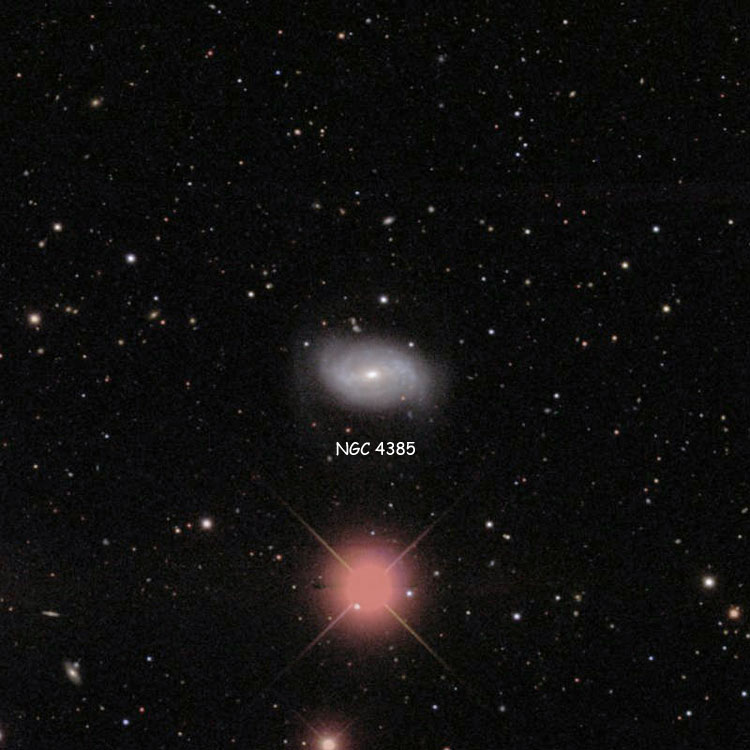
Above, a 12 arcmin wide SDSS image centered on NGC 4385
Below, a 2.8 arcmin wide SDSS image of the galaxy
 Below, a 1 arcmin wide image of the galaxy (Image Credit Hubble Legacy Archive; processing by Courtney Seligman) Below, a 1 arcmin wide image of the galaxy (Image Credit Hubble Legacy Archive; processing by Courtney Seligman)

NGC 4386 (= PGC 40378)
Discovered (Dec 10, 1797) by William Herschel
A 12th-magnitude lenticular galaxy (type SB0) in Draco (RA 12 24 28.4, Dec +75 31 44)
Apparent size 2.5 by 1.3 arcmin.

Above, a 2.4 arcmin wide closeup of NGC 4386
Below, a 12 arcmin wide region centered on the galaxy
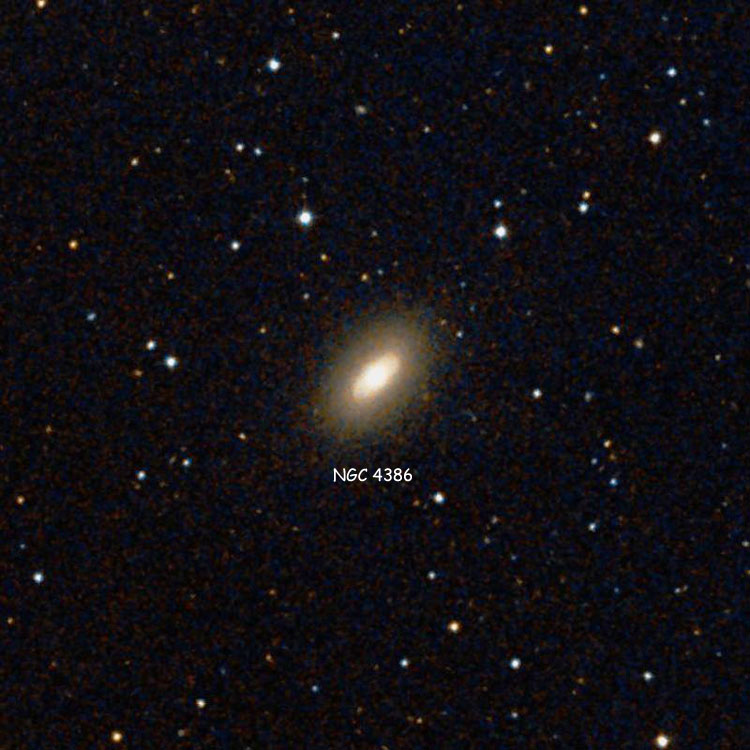
NGC 4387 (= PGC 40562)
Discovered (Apr 17, 1784) by William Herschel
Also observed (date?) by John Herschel
Also observed (date?) by Heinrich d'Arrest
A 12th-magnitude elliptical galaxy (type E3?) in Virgo (RA 12 25 41.7, Dec +12 48 38)
Historical Identification: Per Dreyer, NGC 4387 (= GC 2955 = JH 1250 = WH II 167, d'Arrest, 1860 RA 12 18 36, NPD 76 25.0) is "pretty faint, very small, round, 13th magnitude star 90 arcsec to northwest, northwestern of 2", the other being NGC 4388.
Physical Information: Apparent size 1.6 by 1.1 arcmin? Listed as a member (VCC 828) of the Virgo Cluster.

Above, a 12 arcmin wide SDSS image centered on NGC 4387
Below, a 2.4 arcmin wide SDSS image of the galaxy

NGC 4388 (= PGC 40581)
Discovered (Apr 17, 1784) by William Herschel
Also observed (May 4, 1829) by John Herschel
A magnitude 11.0 spiral galaxy (type (R)SA(s)b? pec) in Virgo (RA 12 25 46.8, Dec +12 39 43)
Historical Identification: Per Dreyer, NGC 4388 (= GC 2949 = GC 2956 = JH 1244 = WH II 168, 1860 RA 12 18 41, NPD 76 33.8), is "very faint, extended, southeastern of 2", the other being NGC 4387.
Physical Information: Based on a recessional velocity of 2525 km/sec, NGC 4388 is about 115 to 120 million light years away, in reasonable agreement with widely varying redshift-independent distance estimates of 45 to 125 million light years. Given that and its apparent size of about 6.2 by 1.6 arcmin (from the images below), it is about 210 to 215 thousand light years across. However, the galaxy is listed as a member (VCC 836) of the Virgo Cluster, and its peculiar appearance (as if a spiral galaxy were embedded in an elliptical galaxy) is thought to be due to gravitational or physical interactions with members of that cluster, in which case it would only be about 50 to 60 million light years away (the latter number being the distance given in the Hubble site page linked below), and about 105 to 110 thousand light years across, which is probably a more reasonable size estimate. NGC 4388 is listed as a Seyfert galaxy (type Sy 1).

Above, a 12 arcmin wide SDSS image centered on NGC 4388
Below, a 6.8 arcmin wide SDSS image of the galaxy

Below, a 1.4 by 2.8 arcmin wide image of part of the galaxy (Image Credit ESA/Hubble & NASA)
(North is on the right, to allow for greater detail)

NGC 4389 (= PGC 40537)
Discovered (Apr 10, 1788) by William Herschel
A 12th-magnitude spiral galaxy (type SB(rs)bc pec?) in Canes Venatici (RA 12 25 35.2, Dec +45 41 05)
Apparent size 2.6 by 1.3 arcmin.

Above, a 3 arcmin wide closeup of NGC 4389
Below, a 12 arcmin wide region centered on the galaxy

NGC 4390 ( = PGC 40597 = IC 3320)
Discovered (Mar 15, 1784) by William Herschel (and later listed as NGC 4390)
Discovered (Sep 6, 1900) by Arnold Schwassmann (and later listed as IC 3320)
A 13th-magnitude spiral galaxy (type SAB(s)c?) in Virgo (RA 12 25 50.7, Dec +10 27 33)
(The duplicate entry was caused by Herschel's position being a bit off; more to follow in the next iteration of this page.) Apparent size 1.6 by 1.2 arcmin. Listed as a member (VCC 849) of the Virgo Cluster.
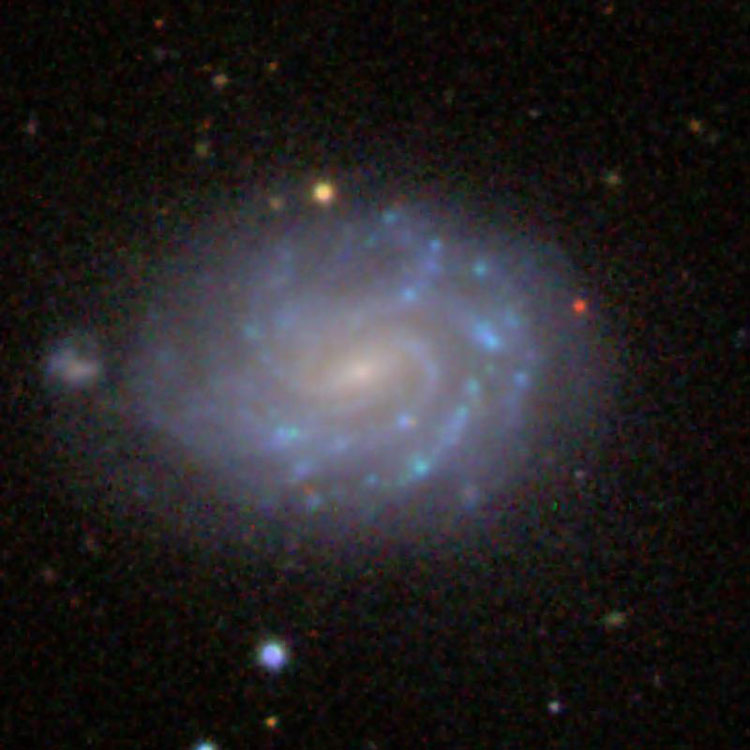
Above, a 3 arcmin wide closeup of NGC 4390
Below, a 12 arcmin wide region centered on the galaxy
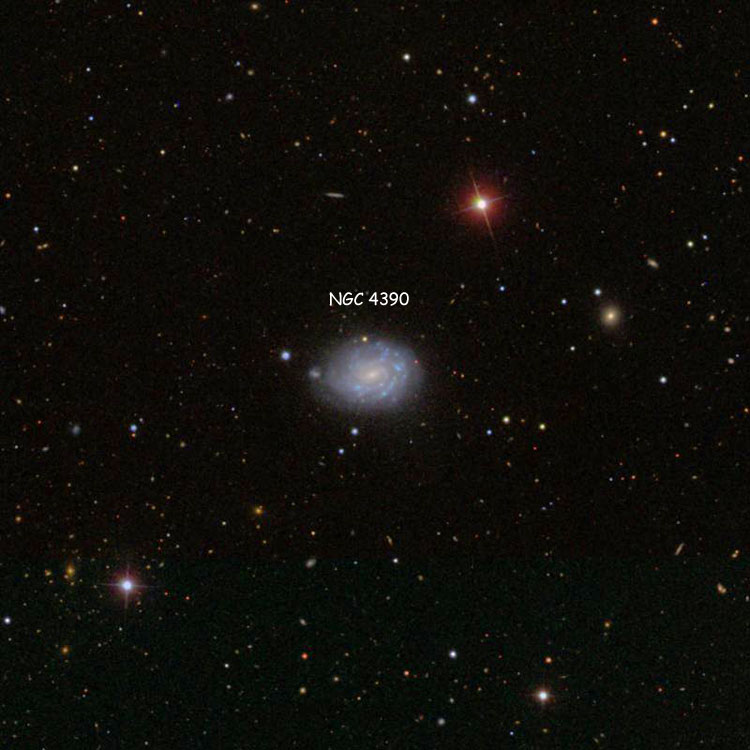
NGC 4391 (= PGC 40500)
Discovered (Mar 20, 1790) by William Herschel
A 13th-magnitude lenticular galaxy (type SA0-?) in Draco (RA 12 25 18.8, Dec +64 56 00)
Apparent size 1.1 by 1.1 arcmin.

Above, a 2.4 arcmin wide closeup of NGC 4391
Below, a 12 arcmin wide region centered on the galaxy

NGC 4392 (= PGC 40499)
Discovered (Apr 27, 1788) by William Herschel
A 14th-magnitude lenticular galaxy (type S0/a pec) in Canes Venatici (RA 12 25 19.0, Dec +45 50 51)
Surrounded (though primarily in the north-south direction) by an extensive region filled with material strewn into intergalactic space, presumably as the result of an interation with a small companion nearly in contact with the west side of its nucleus. Apparent size of central region is only 1.0 by 0.8 arcmin, but the extended outer regions cover nearly 4 by 2 arcmin.

Above, a 4 arcmin wide closeup of NGC 4392 and its extended outer regions
Below, a 12 arcmin wide region centered on the galaxy
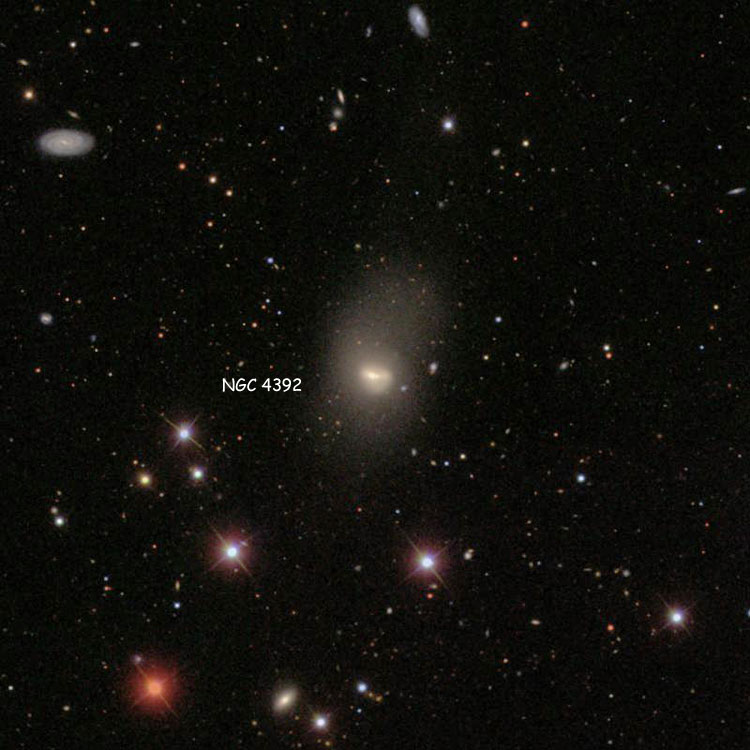
NGC 4393 (= PGC 40600)
Discovered (Apr 11, 1785) by William Herschel
A 13th-magnitude spiral galaxy (type SABd) in Coma Berenices (RA 12 25 51.3, Dec +27 33 39)
Apparent size 3.2 by 3.0 arcmin.

Above, a 3.6 arcmin wide closeup of NGC 4393, also showing IC 3323 and 3329
Below, a 12 arcmin wide region centered on the galaxy,

NGC 4394 (= PGC 40614)
Discovered (Mar 14, 1784) by William Herschel
An 11th-magnitude spiral galaxy (type (R)SB(r)b) in Coma Berenices (RA 12 25 55.6, Dec +18 12 50)
Apparent size 3.4 by 3.2 arcmin. Listed as a member (VCC 857) of the Virgo Cluster.
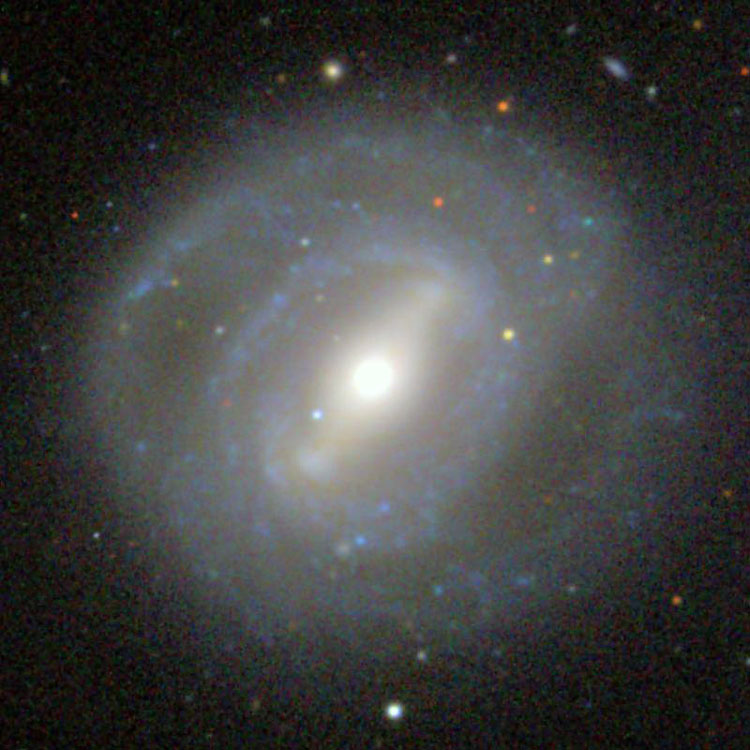
Above, a 4 arcmin wide closeup of NGC 4394
Below, a 12 arcmin wide region centered on the galaxy, also showing NGC 4382 and 4397
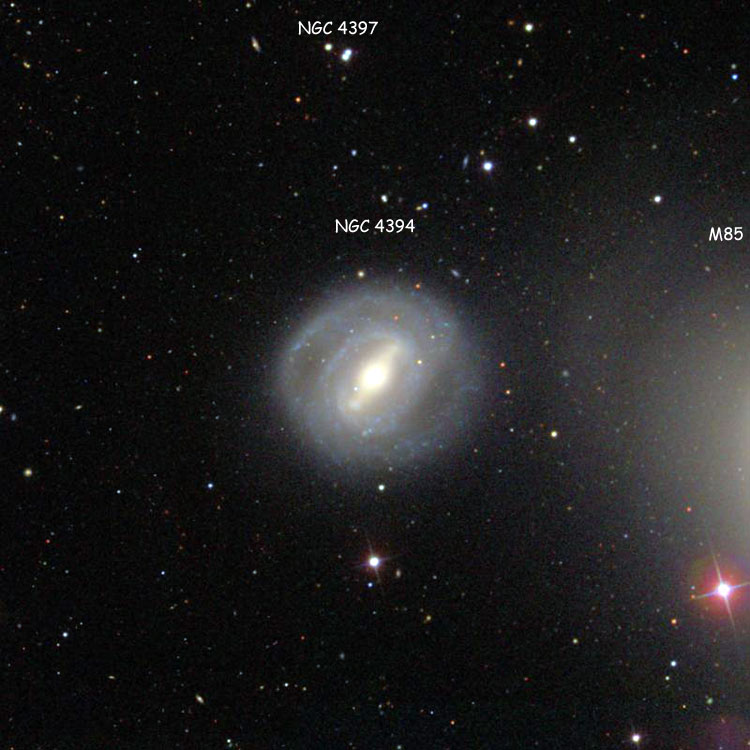
NGC 4395 (= PGC 40596)
Discovered (Jan 2, 1786) by William Herschel
A 10th-magnitude spiral galaxy (type SA(s)m)? in Canes Venatici (RA 12 25 48.9, Dec +33 32 49)
A chaotic galaxy with several bright ionized hydrogen (HII) regions, three of which received their own NGC designations: NGC 4399, 4400, and 4401. The recessional velocity of 320 km/sec is too small to be a reliable distance indicator, as the peculiar (non-Hubble expansion) velocity for the galaxy could be a substantial portion of the value. But as it happens, the 15 million light year distance implied by the recessional velocity is in good agreement with redshift-independent distance estimates of 12 to 15 million light years. Given that and its apparent size of 13.2 by 11.0 arcmin, NGC 4395 is about 55 thousand light years across. Listed as a Seyfert galaxy (type Sy 1.8). 
Above, a 15 arcmin wide closeup of NGC 4395
Below, a labeled version showing the HII regions listed as NGC 4399, 4400, and 4401

NGC 4396 (= PGC 40622)
Discovered (Apr 20, 1865) by Heinrich d'Arrest
A 13th-magnitude spiral galaxy (type SAd?) in Coma Berenices (RA 12 25 59.0, Dec +15 40 17)
Apparent size 3.3 by 1.0 arcmin. Listed as a member (VCC 865) of the Virgo Cluster.
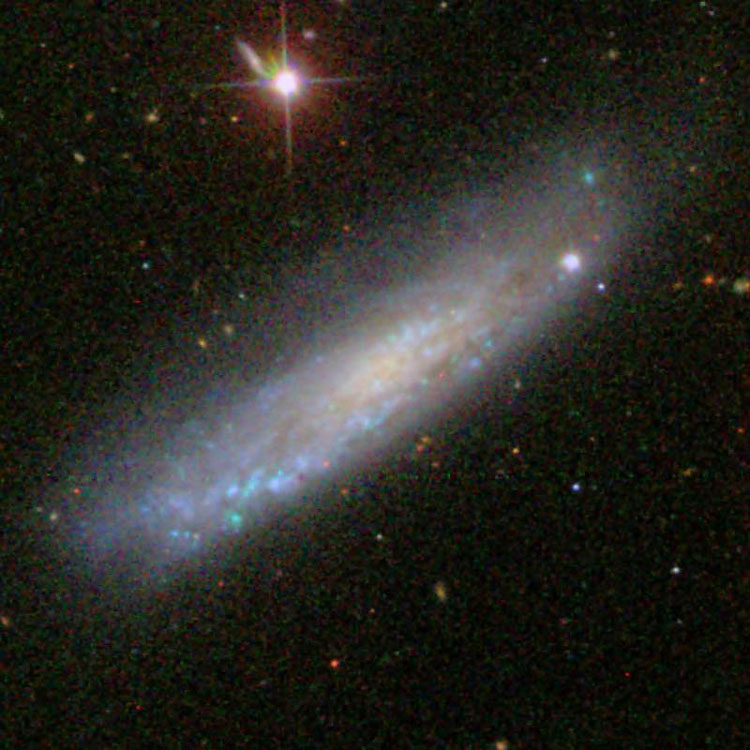
Above, a 3.6 arcmin wide closeup of NGC 4396
Below, a 12 arcmin wide region centered on the galaxy
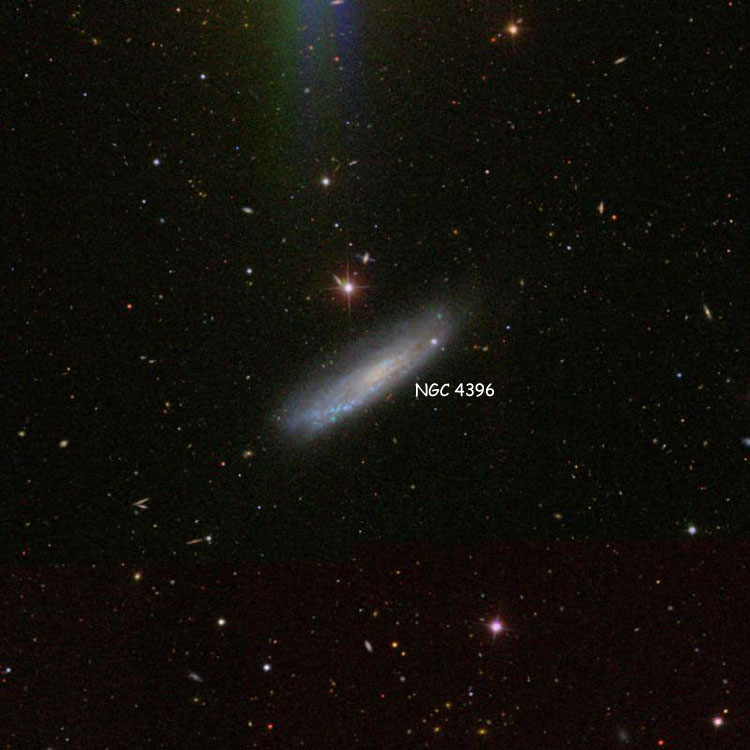
NGC 4397
Recorded (1877) by Wilhelm Tempel
A 13th-magnitude double star in Coma Berenices (RA 12 25 57.9, Dec +18 18 01)
and the 16th-magnitude star at RA 12 25 58.8, Dec +18 18 06
Per Dreyer, NGC 4397 (Tempel list I (#44), 1860 RA 12 18 57, NPD 70 54.7) is "very faint, small, II 55 to southwest", (WH) II 55 being NGC 4394 (which see for an image; also see NGC 4382 for a wider view). The second IC adds "Not found by Frost on plate of 4 hours exposure". The position precesses to RA 12 26 01.1, Dec +18 18 45, but there is nothing there. Per Corwin, Tempel stated that his #44 was 5 seconds east and 6 arcmin north of (WH) II 55, or NGC 4394, which puts the object in essentially the same place as stated by Dreyer, so the position must be correct. The only reasonable explanation is that the triplet of stars listed above, which lies about an arcmin southwest of the NGC position, must be what Tempel observed and Dreyer recorded as NGC 4397. Since this is a stellar object, it is hardly surprising that Frost failed to find a nebula near the position.
NGC 4398
Recorded (Apr 19, 1865) by Heinrich d'Arrest
A 13th-magnitude star in Virgo (RA 12 26 07.4, Dec +10 41 10)
Per Dreyer, NGC 4398 (GC 5646, d'Arrest, 1860 RA 12 18 59, NPD 78 32.4) is "faint, pretty small, III 39 preceding (to west) by 14 seconds, and 14 arcmin south", III 39 being NGC 4390. The second IC adds "Not found by Frost on plate of 4 hours exposure". The position precesses to RA 12 26 05.7, Dec +10 41 03, but there is nothing there save for the star listed above, which is just east of the precessed position. The identity of the star with the NGC entry is certain, as the relative position of NGC 4390 is almost exactly as stated by Dreyer. Since this is a stellar object, it is hardly surprising that Frost failed to find a nebula near the position.

Above, a 12 arcmin wide region centered on the star listed as NGC 4398
NGC 4399
Discovered (Apr 13, 1850) by George Stoney
An emission region in Canes Venatici (RA 12 25 43.1, Dec +33 30 57)
Part of spiral galaxy NGC 4395. Dreyer lists NGC 4399 as reported by Stoney's employer, William Parsons, but notes that most of his discoveries were actually made by his assistants.

Above, a 2.4 arcmin wide closeup of NGC 4399
Below, a labeled image of NGC 4395 showing the HII regions listed as NGC 4399, 4400, and 4401

|